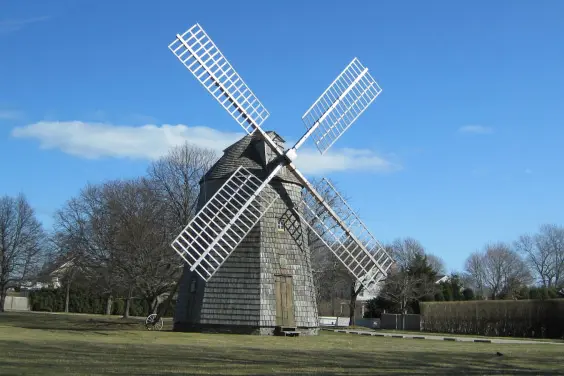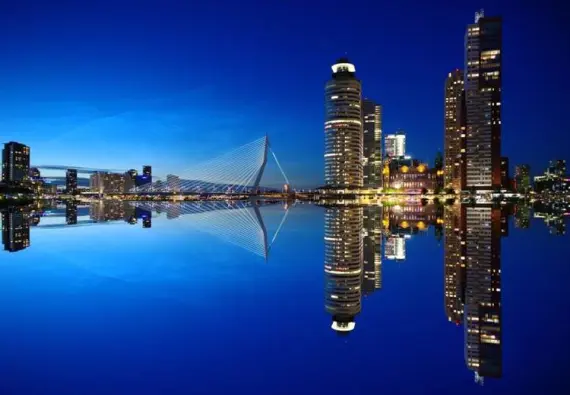Bus POLKOWICE - ROTTERDAM. Order a ticket
POLKOWICE

Polkowice is located in the Lower Silesian province northwest of Wroclaw. This small town has a population of more than 22,000 and is primarily famous as a so-called copper town belonging to the Legnica-Glogów Copper District. However, its history goes back much further than the years of the 19th-century industrial revolution. In 1291 Polkowice was granted a city charter, having previously been a market settlement on the trade route between Glogow and Legnica.
When visiting Polkowice, it is essential to see the well-preserved market square, full of colorful tenement houses, together with the town hall building dating back to the 18th century and the Gothic church of St. Michael the Archangel dating back to 1679. The symbol and unquestionable attraction of Polkowice is the Dutch windmill, inside of which you can learn more about the history of this Piast stronghold at the dawn of time, and from the observation deck at its top admire the panorama of the city.
An ideal place for those who want active rest in the midst of nature and greenery will be the Central Park of Fun and Leisure located in the center of Polkowice. On its territory you will find an amphitheater, a playground, a fountain or even an open-air library.
Polkowice - bus, train or own transport
Getting to Polkowice by car or bus should not be a problem, as the city lies on the S3 expressway and provincial road 331. The Polkowice PKS bus stop can be found near the historic windmill on Mlynska Street, from where numerous domestic and international bus connections depart. However, trains do not reach the town and it has no railroad station.
Polkowice is located in the Lower Silesian province northwest of Wroclaw. This small town has a population of more than 22,000 and is primarily famous as a so-called copper town belonging to the Legnica-Glogów Copper District. However, its history goes back much further than the years of the 19th-century industrial revolution. In 1291 Polkowice was granted a city charter, having previously been a market settlement on the trade route between Glogow and Legnica.
When visiting Polkowice, it is essential to see the well-preserved market square, full of colorful tenement houses, together with the town hall building dating back to the 18th century and the Gothic church of St. Michael the Archangel dating back to 1679. The symbol and unquestionable attraction of Polkowice is the Dutch windmill, inside of which you can learn more about the history of this Piast stronghold at the dawn of time, and from the observation deck at its top admire the panorama of the city.
An ideal place for those who want active rest in the midst of nature and greenery will be the Central Park of Fun and Leisure located in the center of Polkowice. On its territory you will find an amphitheater, a playground, a fountain or even an open-air library.
Polkowice - bus, train or own transport
Getting to Polkowice by car or bus should not be a problem, as the city lies on the S3 expressway and provincial road 331. The Polkowice PKS bus stop can be found near the historic windmill on Mlynska Street, from where numerous domestic and international bus connections depart. However, trains do not reach the town and it has no railroad station.
ROTTERDAM

Rotterdam is a large port city in the west of the Netherlands in the Province of South Holland with a population of over 620,000. It lies in the Rhine-Meuse delta, and is connected to the North Sea by the 30-kilometer-long Nieuwe Waterweg canal.
Rotterdam was first mentioned in 1283. It received city rights in 1299, and developed significantly in the 17th and 18th centuries through trade with France and England or the shipping industry. Rotterdam's seaport already played a significant role in the life of the city and still impresses today with its size and capabilities.
If you want to get to know Rotterdam, start your tour with the Gothic St. Lawrence Church, one of the most distinctive buildings, also one of the oldest, but which suffered significantly during the Luftwaffe carpet raids of 1940 - its walls and tower survived then. Today, in addition to its beautiful facade, the church's interior is worth seeing, with its historic altars and tombs. The city also boasts a number of museums full of valuable art collections. Particularly noteworthy is the large Boijmans Van Beuningen museum collecting works by many famous artists, or the Kunsthal Art Museum, which hosts temporary and thematic exhibitions.
Rotterdam is a city that is constantly vibrant. There you can find numerous clubs, discos and pubs, plus there are many events, concerts and festivals. In the summer there is a good chance that you will come across one of the numerous open-air performances, and in the winter - a fair or Christmas market.
Getting to Rotterdam
Rotterdam is a major transportation hub, where highways and railroads intersect. In addition, you'll find an airport and the largest seaport in Europe. The city has five subway lines, as well as streetcars and buses, so getting around Rotterdam and other towns in the metropolitan area in the western Netherlands should not be a problem.
Our buses stop near the Erasmusbrug suspension bridge and the Kunsthal Museum on Zalmstraat 9. Wanting to visit Rotterdam - a bus can be a great choice, especially since it is an inexpensive and more environmentally friendly option than flying or driving your own car. You can find a list of available bus connections to Rotterdam on our website.
Rotterdam is a large port city in the west of the Netherlands in the Province of South Holland with a population of over 620,000. It lies in the Rhine-Meuse delta, and is connected to the North Sea by the 30-kilometer-long Nieuwe Waterweg canal.
Rotterdam was first mentioned in 1283. It received city rights in 1299, and developed significantly in the 17th and 18th centuries through trade with France and England or the shipping industry. Rotterdam's seaport already played a significant role in the life of the city and still impresses today with its size and capabilities.
If you want to get to know Rotterdam, start your tour with the Gothic St. Lawrence Church, one of the most distinctive buildings, also one of the oldest, but which suffered significantly during the Luftwaffe carpet raids of 1940 - its walls and tower survived then. Today, in addition to its beautiful facade, the church's interior is worth seeing, with its historic altars and tombs. The city also boasts a number of museums full of valuable art collections. Particularly noteworthy is the large Boijmans Van Beuningen museum collecting works by many famous artists, or the Kunsthal Art Museum, which hosts temporary and thematic exhibitions.
Rotterdam is a city that is constantly vibrant. There you can find numerous clubs, discos and pubs, plus there are many events, concerts and festivals. In the summer there is a good chance that you will come across one of the numerous open-air performances, and in the winter - a fair or Christmas market.
Getting to Rotterdam
Rotterdam is a major transportation hub, where highways and railroads intersect. In addition, you'll find an airport and the largest seaport in Europe. The city has five subway lines, as well as streetcars and buses, so getting around Rotterdam and other towns in the metropolitan area in the western Netherlands should not be a problem.
Our buses stop near the Erasmusbrug suspension bridge and the Kunsthal Museum on Zalmstraat 9. Wanting to visit Rotterdam - a bus can be a great choice, especially since it is an inexpensive and more environmentally friendly option than flying or driving your own car. You can find a list of available bus connections to Rotterdam on our website.
© 2025 Sindbad
Technical support, assistance, payments: Sindbad IT
© 2025 Sindbad
Technical support, assistance, payments: Sindbad IT
